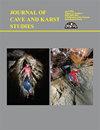Contrasting Microbial Communities in Cave Ferromanganese Deposits With Overlying Surface Soils
IF 0.5
4区 地球科学
Q4 GEOSCIENCES, MULTIDISCIPLINARY
引用次数: 0
Abstract
Arid-land carbonate caves, such as Fort Stanton Cave, receive limited surface input; hence, critical constituents required for microbial communities are often limited. We hypothesized that the microbial communities residing in surface soils would differ from their subsurface counterparts found throughout the Snowy River passage on walls and ceilings in soil-like material ( speleosol ) rich in Fe- and Mn-oxides. Also referred to as ferromanganese deposits (FMDs), these secondary mineral deposits represent low nutrient environments that would likely select for organisms with metabolisms that favor low-nutrient local conditions and may be chemolithotrophic (“rock eaters”). We examined archaeal and bacterial makeup of low-nutrient ferromanganese deposits occurring in Fort Stanton Cave, NM, USA, and in corresponding overlying surface soils. Results of 16S rRNA gene sequencing indicate that bacterial and archaeal communities in the cave are taxonomically significantly dissimilar to their corresponding surface soils. Core microbial constituents of these communities, representing operational taxonomic units (OTUs) occurring in >80% of all samples, determined that there were only 19 and 17 archaeal and bacterial OTUs shared between surface and cave samples, respectively out of the total 1,639 archaeal and 12,051 bacterial OTUs. Surface archaeal communities were primarily represented by the Thaumarchaeota class Soil Crenarchaeotic Group (SCG), which play important roles in nitrogen cycling. Dominant archaeal groups in the subsurface included the Euryarchaeota class Thermoplasmata and Thaumarchaeota classes South African Gold Mine Gp 1 (SAGMCG-1), Marine Group I, and AK31. Bacterial cave OTUs significantly different from surface bacteria included Nitrospirae, GAL15, Omnitrophica , Zixibacteria, Latescibacteria , SBR1093,溶洞锰铁矿床与上覆表层土壤微生物群落对比
干旱地区的碳酸盐岩洞穴,如斯坦顿堡洞穴,接收到的地表输入有限;因此,微生物群落所需的关键成分往往是有限的。我们假设居住在表层土壤中的微生物群落与遍布雪河通道的墙壁和天花板上富含铁和锰氧化物的类土物质(洞穴溶质)中的地下对应体不同。这些次生矿床也被称为锰铁矿床(FMDs),它们代表了低营养环境,可能会选择具有有利于低营养当地条件的代谢的生物,并且可能是趋化石营养(“食石者”)。我们研究了发生在Fort Stanton Cave, NM, USA的低营养锰铁沉积物的古细菌和细菌组成,以及相应的覆盖表面土壤。16S rRNA基因测序结果表明,洞内细菌和古细菌群落在分类上与其对应的表层土壤存在显著差异。这些群落的核心微生物组分,代表了所有样品中80%以上的操作分类单元(otu),确定了地表和洞穴样品中只有19个和17个古细菌和细菌的otu,分别在1,639个古细菌和12,051个细菌otu中共享。表层古细菌群落以土壤绿古菌群(SCG)为代表,在氮循环中起重要作用。地下优势古菌群包括Euryarchaeota类Thermoplasmata和Thaumarchaeota类South African Gold Mine Gp 1 (SAGMCG-1)、Marine Group I和AK31。细菌洞穴OTUs与地表细菌差异显著的有Nitrospirae、GAL15、Omnitrophica、Zixibacteria、Latescibacteria、SBR1093、
本文章由计算机程序翻译,如有差异,请以英文原文为准。
求助全文
约1分钟内获得全文
求助全文
来源期刊

Journal of Cave and Karst Studies
地学-地球科学综合
CiteScore
1.90
自引率
0.00%
发文量
6
审稿时长
>12 weeks
期刊介绍:
The Journal of Cave and Karst Studies is a multidisciplinary journal devoted to cave and karst research. The Journal is seeking original, unpublished manuscripts concerning the scientific study of caves or other karst features. Authors do not need to be members of the National Speleological Society, but preference is given to manuscripts of importance to North American speleology.
 求助内容:
求助内容: 应助结果提醒方式:
应助结果提醒方式:


